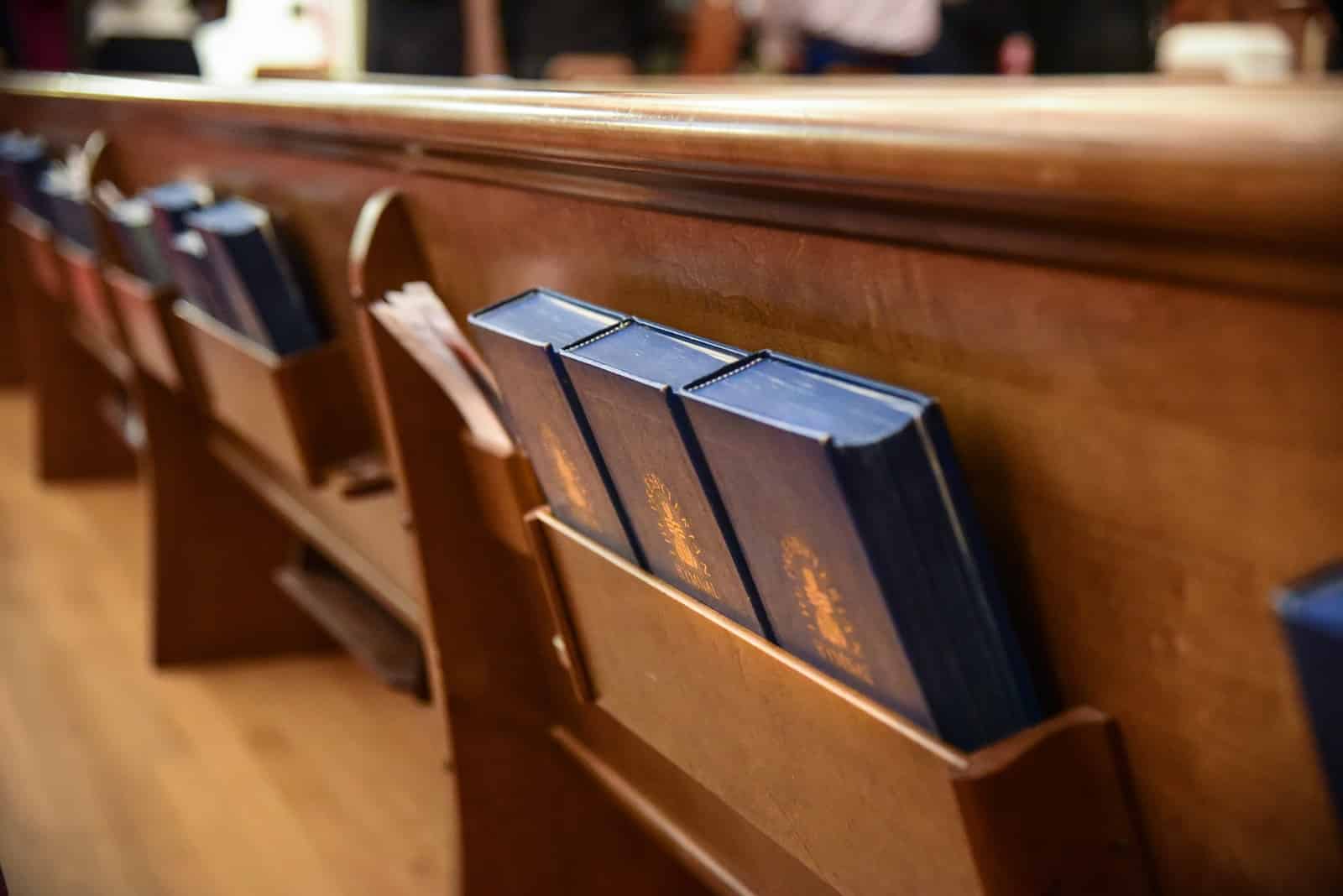In AD 386, the hymn as we know it was born. Not at a scholar’s desk or in a choir loft, but in a besieged church. The troops of Justina encircled the Cathedral of Milan, threatening to take Bishop Ambrose into captivity and set up an Arian leader in his place. The only reason they had not yet burst through the door was that they feared the people who remained, supporting their bishop. It was at this crucial moment that Ambrose earned his title as the father of Western hymnody, leading his people in song and strengthening their resolve.
Ambrose was one of the first Christians to compose original songs for the Latin church. Though a few men before him had written metrical music for corporate worship, Ambrose’s hymns surpassed those of his predecessors in both quantity and quality.1David R. Breed and Charles N. Boyd, The History and Use of Hymns and Hymn-Tunes (New York: Fleming H. Revell Co., 1903), 26.
Ambrose so defined the next thousand years of church music, that Martin Luther translated him into German for the first hymnbook of the Reformation,2Jane Stuart Smith and Betty Carlson, Great Christian Hymn Writers (Wheaton: Crossway, 1997), 29. and the protestant churches modelled many of their hymns on the works of Ambrose.3William Jensen Reynolds, A Survey of Christian Hymnody (New York: Holt, Rinehart and Winston, 1963), 10. His surviving hymns are remarkably similar in form to the great hymns of the faith written by men like Charles Wesley and Isaac Watts. In them, rich theology is set to poetry and sung with simple tunes so that the whole congregation can participate. Though the Church often takes this kind of sacred music for granted, she owes a great debt to Ambrose for his contribution. No other hymn-writer from the first 500 years of church history has so impacted the singing of the modern church.4Vincent A. Lenti, “Saint Ambrose, The Father of Western Hymnody,” The Hymn: A Journal of Congregational Song 48, no. 4 (October 1949): 44.
Aurelius Ambrose, commonly known as Ambrose of Milan, was born in AD 339, in the city of Trier. The Roman Empire had recently become tolerant of Christianity with the conversion of Constantine in 313, and Ambrose became part of a new class of Christian leaders with a classical Roman education. His parents were both Nicene followers of Christ and his Father was the praetorian prefect over a territory spanning modern day France, Spain, Portugal, Britain, and part of Germany. Thus, Ambrose received the best education Rome could offer, as well as being tutored in religion by a Christian pastor named Simplician.
At age 31, after a successful career as a lawyer, Ambrose was appointed governor of Milan. Three years after Ambrose became governor, Auxentius, the Arian Bishop of Milan died. The Nicene and Arian citizens immediately began to riot in the streets, recognizing that the choice of Auxentius’s successor would determine the theological direction of the church in Milan. When Governor Ambrose went out to calm the riots, to his surprise a child’s voice rang out, “Let Ambrose be bishop!” However, Ambrose felt inadequate for the job, as he had not received any extensive theological training.5Faith Cook, Our Hymn-Writers and Their Hymns (Darlington, England: Evangelical Press, 2005), 13. So great was Ambrose’s respect for the office, that he tried no less than five different ways to convince the people that he was not qualified.6Samuel Willoughby Duffield, The Latin Hymn-Writers and Their Hymns (New York: Funk & Wagnalls, 1889), 49.) However, the will of the people prevailed, and Ambrose was made Bishop. As he assumed … Continue reading
In his 23 years as bishop of Milan, Ambrose would become known for his courageous stands against heresy and paganism. He successfully confronted the violence of Emperor Theodosius and the syncretism of Emperor Valentinian, showing remarkable bravery in rebuking the most powerful men of the Roman world. His fiercest adversary was Justina, the mother of emperor Valentinian II. Justina was a committed Arian, who wanted to reclaim the church of Milan from the Nicene doctrine which Ambrose taught. Twice, she sent her troops to Milan, but both times Ambrose and the people of Milan resisted, and Justina’s troops backed down.
It was on one of these occasions, as the Cathedral of Milan was under siege, that Ambrose and his people began to sing. Augustine of Hippo, who was baptized by Ambrose, gave this eyewitness testimony, “Then it was that the custom arose of singing hymns and psalms, after the use of the Eastern parts, lest the people should wax faint through the tediousness of sorrow; and from that day to this the custom has been retained, in many, nay, almost all of the Christian congregations throughout the rest of the world following therein.”7Lenti, “Saint Ambrose, The Father of Western Hymnody,” 46. Some historians say that the attacking soldiers were so impressed with the courageous singing of Ambrose’s people, that they too began to sing before returning to Justina.8Smith and Carlson, Great Christian Hymn Writers, 28.
Until the fourth century AD, the Church sang mostly psalms and a few hymns directly from Scripture.9Ibid., 27.Though Paul’s writings allow for different kinds of songs (Eph 5:18), the practice of singing original compositions in the Roman church is rarely attested before Ambrose. In fact, it is hard to find references to participatory congregational singing in church history before the fourth century, perhaps because the church was often forced to meet underground.10That is not to say that congregational singing was not practiced at all in the early church. Justin Martyr, Clement, Ignatius, and Eusebius all write of common singing in early worship services. … Continue reading Thus, the hymns of Ambrose represent a significant development in corporate worship.11Ibid., 14–28.
One scholar of early church music writes, “The hymns of Ambrose are an innovation, with few precedents in the Christian West.”12Ibid., 13. Though Eastern churches had been writing original hymns for some time, these new Latin hymns far surpassed those of the East in quality and soon overtook them in quantity as well.13Breed and Boyd, The History and Use of Hymns and Hymn-Tunes, 26. Over the next few centuries many hymn-writers imitated Ambrose’s style,14John Anthony McGuckin, The Westminster Handbook to Patristic Theology, 1st ed., The Westminster handbooks to Christian theology (Louisville: Westminster John Knox Press, 2004), 9. making it sometimes difficult to determine which Ambrosian hymns were written by Ambrose himself.15Lawrence J. Johnson, Worship in the Early Church: An Anthology of Historical Sources (Collegeville, Minn.: Liturgical Press, 2009), 77.
Historians do not know what hymns Ambrose and his people sang during the siege of Milan, but we know from the surviving works of Ambrose that theological accuracy, accessibility, and devotion were key aspects of his compositions. One excellent example of Ambrose’s style is found in, Hic Est Dies Verus Dei:
When death through earth has made her path,
Then all the dead shall rise,
And death, consumed by heavenly wrath,
In groans, and lonely, dies16Duffield, The Latin Hymn-Writers and Their Hymns, 61.
His hymns were also Christocentric, as in Splendor Paternae Gloria:
O splendor of the Father’s face,
Affording light from light
Thou light of light, thou fount of grace.
Thou day of day most bright.17bid., 60.
Ambrose’s hymns were designed to arm his people for the Arian controversy and make key doctrines like the Trinity accessible for the average congregant.18Reynolds, A Survey of Christian Hymnody, 10. One example of this is Deus Creator Omnium:
To Christ and to the Father now,
And to the Spirit equally,
We pray for every favoring gift,
One God supreme, a Trinity19Duffield, The Latin Hymn-Writers and Their Hymns, 60.
Where would the Church be without hymns? One author says, “The evangelical song . . . [is] the graceful alliance of poetry and religion, the very climax of refined literature.”( Breed and Boyd, The History and Use of Hymns and Hymn-Tunes, 26.)) Like so many other treasures of church, the hymn was formed in the fires of tribulation. Praise the Lord for Ambrose, who chose to stand and sing while the Roman armies closed in! His bold singing still echoes in the halls of church history. He was a man who “let the truth come mightily . . . with a swing and a vigor which was the outburst of his own majestic soul.” Duffield, The Latin Hymn-Writers and Their Hymns, 53.)) Oh that our churches would learn to sing when trials come, that future generations would be encouraged by our battle-hymns, as we have been encouraged by Ambrose’s.
References
| 1 | David R. Breed and Charles N. Boyd, The History and Use of Hymns and Hymn-Tunes (New York: Fleming H. Revell Co., 1903), 26. |
|---|---|
| 2 | Jane Stuart Smith and Betty Carlson, Great Christian Hymn Writers (Wheaton: Crossway, 1997), 29. |
| 3 | William Jensen Reynolds, A Survey of Christian Hymnody (New York: Holt, Rinehart and Winston, 1963), 10. |
| 4 | Vincent A. Lenti, “Saint Ambrose, The Father of Western Hymnody,” The Hymn: A Journal of Congregational Song 48, no. 4 (October 1949): 44. |
| 5 | Faith Cook, Our Hymn-Writers and Their Hymns (Darlington, England: Evangelical Press, 2005), 13. |
| 6 | Samuel Willoughby Duffield, The Latin Hymn-Writers and Their Hymns (New York: Funk & Wagnalls, 1889), 49.) However, the will of the people prevailed, and Ambrose was made Bishop. As he assumed his new role, Ambrose gave away his immense family riches and began to study the Scriptures diligently, developing a reputation as a formidable preacher and theologian.((Calvin Stapert, A New Song For an Old World: Musical Thought in the Early Church, The Calvin Institute of Christian Worship Liturgical Studies Series (Grand Rapids: Eerdmans, 2007), 93–99. |
| 7 | Lenti, “Saint Ambrose, The Father of Western Hymnody,” 46. |
| 8 | Smith and Carlson, Great Christian Hymn Writers, 28. |
| 9 | Ibid., 27. |
| 10 | That is not to say that congregational singing was not practiced at all in the early church. Justin Martyr, Clement, Ignatius, and Eusebius all write of common singing in early worship services. However, it is far more commonly attested after the fourth century as Brian Dunkle points out in Enchantment and Creed in the Hymns of Ambrose of Milan, First edition., Oxford Early Christian Studies (Oxford: Oxford University Press, 2016), 15. |
| 11 | Ibid., 14–28. |
| 12 | Ibid., 13. |
| 13 | Breed and Boyd, The History and Use of Hymns and Hymn-Tunes, 26. |
| 14 | John Anthony McGuckin, The Westminster Handbook to Patristic Theology, 1st ed., The Westminster handbooks to Christian theology (Louisville: Westminster John Knox Press, 2004), 9. |
| 15 | Lawrence J. Johnson, Worship in the Early Church: An Anthology of Historical Sources (Collegeville, Minn.: Liturgical Press, 2009), 77. |
| 16 | Duffield, The Latin Hymn-Writers and Their Hymns, 61. |
| 17 | bid., 60. |
| 18 | Reynolds, A Survey of Christian Hymnody, 10. |
| 19 | Duffield, The Latin Hymn-Writers and Their Hymns, 60. |




